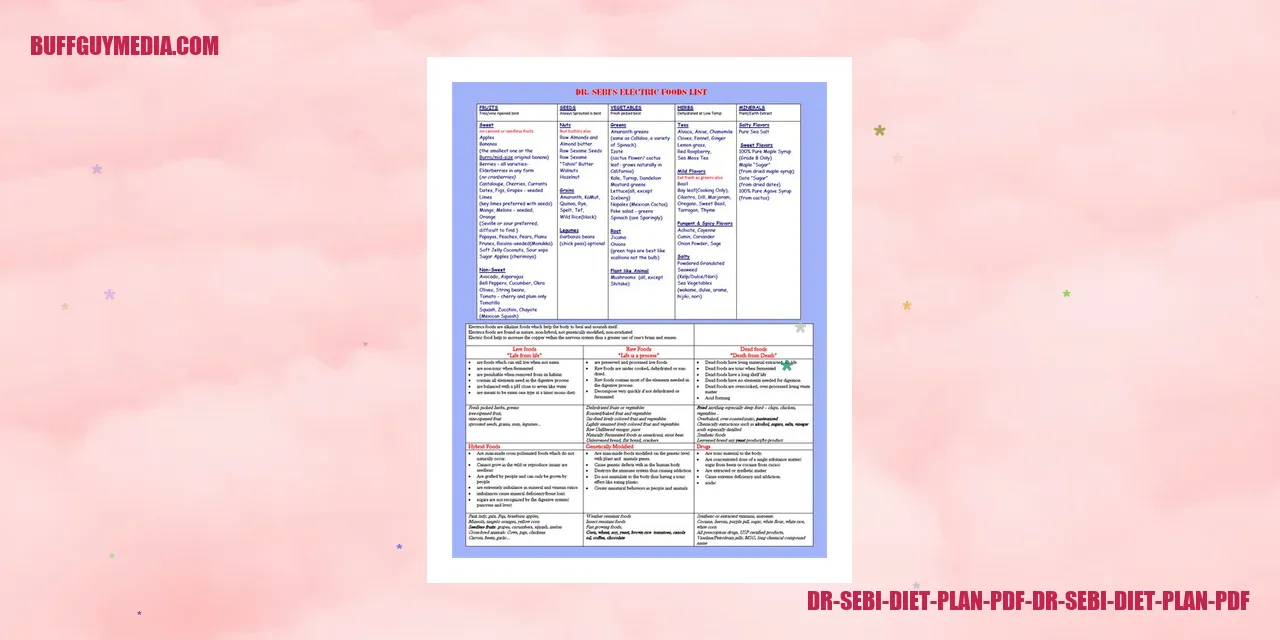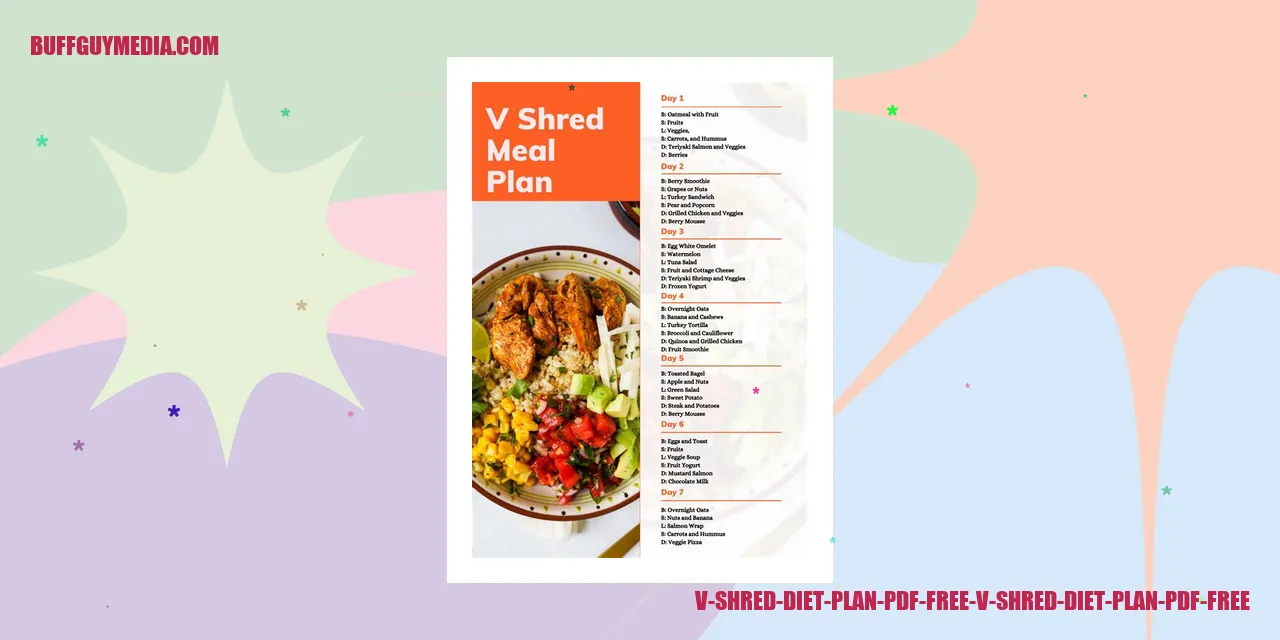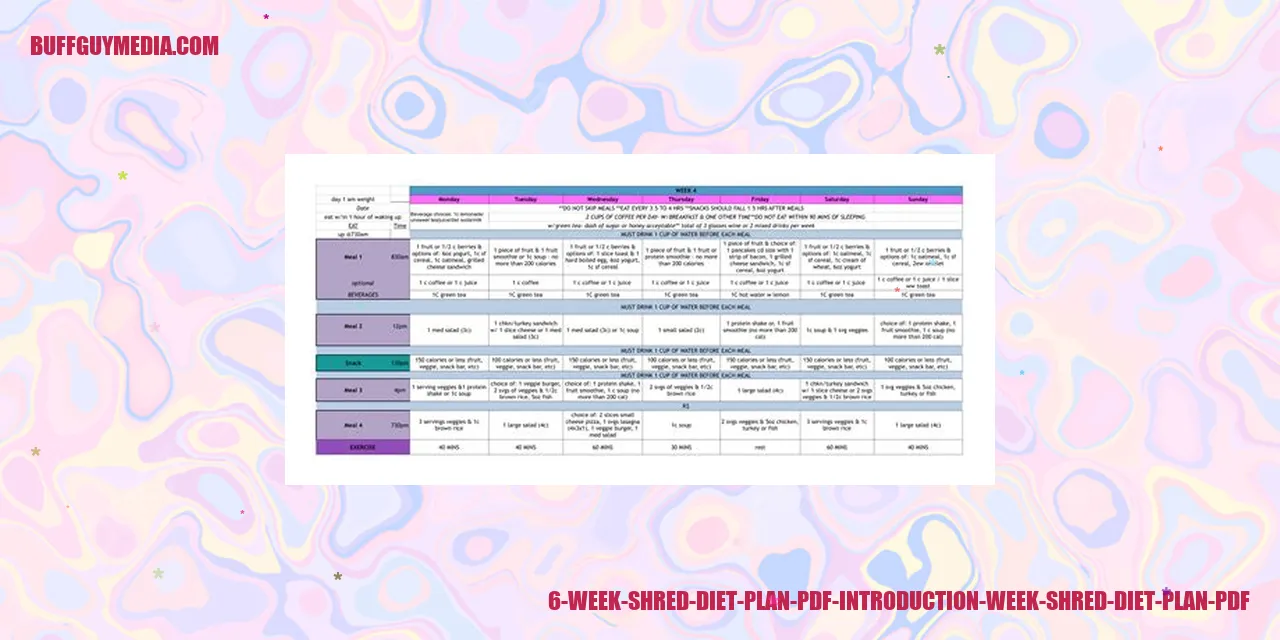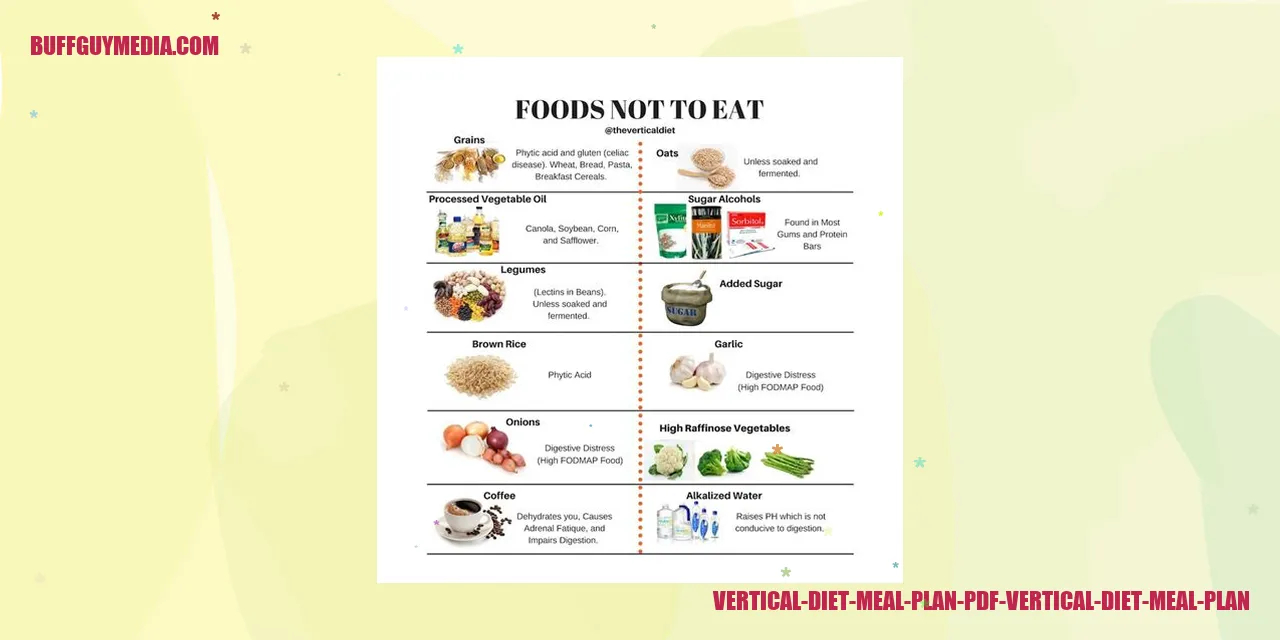Vertical Diet Meal Plan PDF: Your Ultimate Guide to Healthy Eating
The Ins and Outs of the Vertical Diet Meal Plan
Introduction to the Vertical Diet
The Vertical Diet, formulated by renowned strength coach Stan Efferding, is a nutritional regimen that aims to optimize both health and performance. This unique diet emphasizes the consumption of nutrient-rich foods and addresses specific micronutrient deficiencies. Popular among athletes and bodybuilders, the Vertical Diet supports muscle growth, improves digestion, and boosts overall energy levels.
Key Principles of the Vertical Diet
The core principles of the Vertical Diet revolve around the strategic intake of easily digestible carbohydrates, high-quality proteins, and healthy fats. This eating plan focuses on whole foods abundant in essential vitamins and minerals, such as lean meats, rice, fruits, and vegetables. Adequate hydration is also emphasized, along with frequent consumption of easily digestible meals to prevent gastrointestinal issues.
Benefits of Following the Vertical Diet
By adhering to the Vertical Diet, you can reap several benefits. Firstly, it promotes optimal gastrointestinal health, reducing the likelihood of bloating and indigestion. The diet also helps regulate blood sugar levels, providing sustained energy throughout the day. Furthermore, the synergy of nutrient-dense foods in this meal plan supports muscle recovery, growth, and superior performance during workouts. Additionally, the Vertical Diet may aid in weight management as it emphasizes satiety-promoting, nutrient-rich foods.
Sample Vertical Diet Meal Plan
To provide you with an example of a typical Vertical Diet meal plan, we have outlined one below:
- Breakfast: 4-6 whole eggs, white jasmine rice, spinach
- Mid-morning snack: Grass-fed beef, white jasmine rice, mixed vegetables
- Lunch: Wild-caught salmon, white jasmine rice, sweet potatoes, steamed broccoli
- Afternoon shake: Whey protein powder, banana, spinach, almond milk
- Dinner: Grass-fed steak, with white jasmine rice, asparagus, mixed greens salad
- Evening snack: Greek yogurt with blueberries and almond butter
[[READMORE]]
This sample meal plan exemplifies the principle of incorporating diverse protein sources, carbohydrates, and vegetables in each meal. Keep in mind that individual dietary needs and preferences may vary, so it is advisable to consult a nutrition professional or dietitian for personalized guidance.
Also read:
The Amazing Before and After Photos of Lucas Black’s Remarkable Transformation
Metaboost Diet Plan PDF: Achieve Your Weight Loss Goals
By embracing the Vertical Diet as a part of your lifestyle, you can optimize your nutrition intake, enhance physical performance, and promote overall well-being. Remember, consistency and balance are key to achieving your health and fitness goals with any dietary plan.

The Vertical Diet: A Powerful Tool for Weight Loss
Incorporating the Vertical Diet into Your Weight Loss Journey
The revolutionary Vertical Diet, designed by the esteemed powerlifter and nutrition guru Stan Efferding, has garnered immense popularity among athletes, fitness enthusiasts, and individuals seeking to shed those extra pounds. Known for its simplicity and focus on nutrient-rich meals, this diet offers a sustainable approach to weight loss.
By emphasizing both the quality and quantity of food, the Vertical Diet supports weight loss by offering a well-rounded meal plan consisting of essential nutrients crucial for optimal health. This plan advocates for whole foods such as lean proteins, fruits, vegetables, and whole grains while discouraging the consumption of processed foods and added sugars. Such an approach ensures that your body receives nourishment while minimizing excess calories and harmful additives.
Furthermore, the Vertical Diet facilitates weight loss by prioritizing portion control. Tailoring meals to individual needs enables the creation of a calorie deficit, a fundamental requirement for shedding pounds. Additionally, this diet encourages mindful eating, allowing individuals to listen attentively to their bodies and recognize hunger and satiety signals.
Inspiring Success Stories of Weight Loss Achieved with the Vertical Diet
A myriad of individuals have triumphantly embarked on their weight loss journeys through the Vertical Diet. One shining example is Sarah, a hardworking professional who battled with her weight for years. After adopting the Vertical Diet into her daily routine, Sarah observed remarkable transformations in her body composition.
She attributes her weight loss triumph to the simplicity and flexibility of the Vertical Diet. The diet’s ability to offer a wide array of nutrient-dense foods made it sustainable for Sarah. Additionally, she appreciated the emphasis on portion control, as it fostered a deeper understanding of her body’s requirements and facilitated moderation in eating.
Overcoming Common Challenges: Weight Loss with the Vertical Diet
While the Vertical Diet brings forth a multitude of benefits for weight loss, some individuals may encounter specific challenges along the way. One prevalent hurdle lies within the initial adjustment period, during which individuals must familiarize themselves with the diet’s specific guidelines and food selection.
To conquer this challenge, it is advised to gradually incorporate the Vertical Diet into your routine. Start by introducing one or two components of the diet and progressively increase these changes over time. This approach ensures a smoother transition and enhances the likelihood of long-term success.
Another typical obstacle involves adhering to the diet while dining out or attending social events. The Vertical Diet encourages flexibility and provides solutions to navigate these circumstances. Strategic planning, informed decision-making, and clear communication of your dietary preferences can significantly assist in overcoming these challenges and staying on track with your weight loss goals.
Incorporating the Vertical Diet into your weight loss journey can yield numerous benefits for your overall health and well-being. Through its emphasis on whole foods, portion control, and personalized meal planning, this diet offers a sustainable and effective approach to achieving weight loss goals.]

The Vertical Diet: Unlocking Athletic Performance Potential
Optimizing Energy Levels and Endurance with the Vertical Diet
The Vertical Diet has garnered considerable attention within the athletic community due to its innovative approach in bolstering energy levels and endurance for athletes. Crafted by renowned nutritionist Stan Efferding, this unique eating plan emphasizes the consumption of nutrient-rich foods to support optimal athletic performance and overall well-being.
Enhancing Energy Levels and Stamina with the Vertical Diet
Athletes require a steady and reliable supply of energy to fuel their rigorous training sessions and competitive pursuits. The Vertical Diet places emphasis on the consumption of high-quality carbohydrates, such as potatoes, rice, and oats, as they serve as a sustainable source of glucose for energy production.
Furthermore, the Vertical Diet underscores the significance of consuming an ample amount of protein to facilitate muscle repair and growth. Athletes are advised to incorporate lean meats like beef and chicken, along with eggs and dairy products, to meet their protein requirements effectively.
In addition, the Vertical Diet promotes the intake of easily digestible foods to prevent gastrointestinal discomfort during physical activities. This includes including fruits, vegetables, and easily digestible grains like white rice as part of each meal.
Strategic Nutrient Timing and Meal Frequency for Athletes on the Vertical Diet
The Vertical Diet underscores the importance of strategic nutrient timing and meal frequency to optimize performance. Athletes are encouraged to consume well-balanced macronutrient meals regularly, with a specific focus on consuming carbohydrates and proteins before and after workouts.
Prior to a workout, athletes should fuel their bodies with easily digestible carbohydrates, such as fruits or white rice, to provide immediate energy. Incorporating a source of protein, such as a chicken breast or a whey protein shake, can also aid in muscle recovery and synthesis during the workout.
Post-workout meals are crucial for replenishing glycogen stores and promoting muscle recovery. Athletes following the Vertical Diet are advised to consume a combination of carbohydrates and protein within 30 minutes of completing their workout. This might include a meal consisting of lean meat, accompanied by sweet potatoes, or a protein shake fortified with carbohydrates.
Pre and Post-Workout Meal Suggestions on the Vertical Diet
Here are some examples of pre and post-workout meal options aligned with the principles of the Vertical Diet:
Pre-workout meal suggestions:
– Grilled chicken breast with white rice and steamed asparagus
– Egg white omelet with spinach and a side of roasted sweet potatoes
– Greek yogurt with mixed berries and a handful of walnuts
Post-workout meal suggestions:
– Baked salmon fillet with quinoa and oven-roasted Brussels sprouts
– Lean beef stir-fry with brown rice and a medley of stir-fried vegetables
– Cottage cheese with fresh pineapple chunks and whole grain crackers
The Vertical Diet offers athletes a comprehensive meal plan that prioritizes nutrient-dense foods to optimize energy levels, endurance, and overall performance. By adhering to the principles of the Vertical Diet and strategically timing their meals, athletes can effectively fuel their bodies and facilitate efficient recovery, leading to enhanced athletic performance.
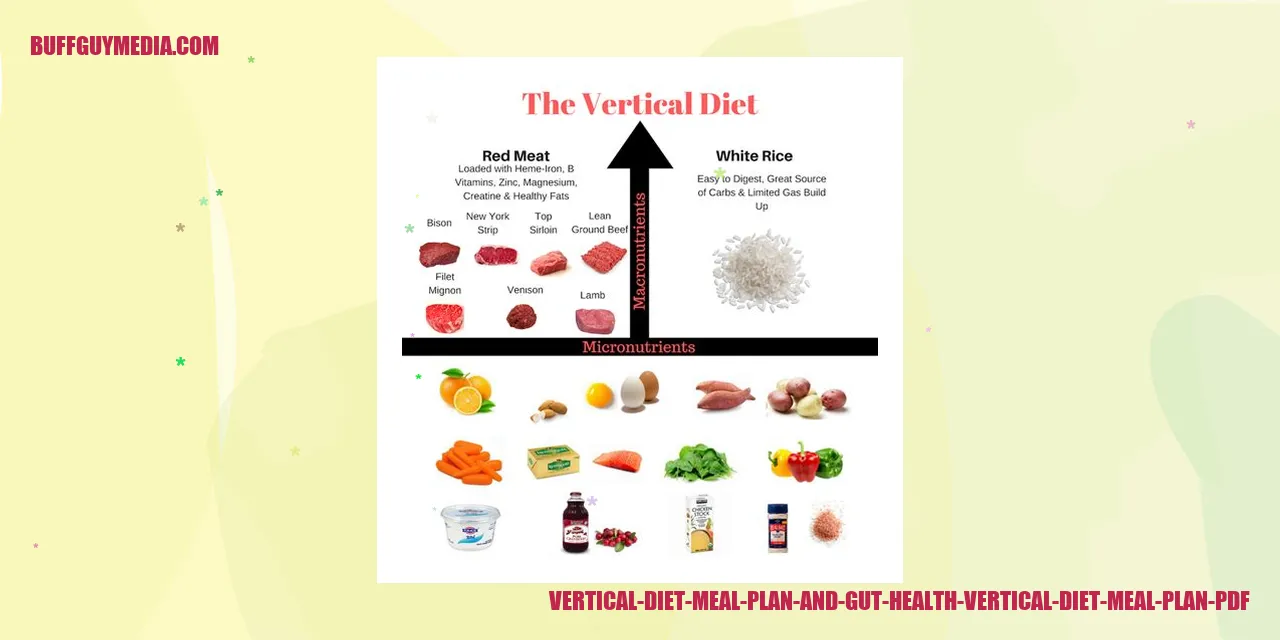
The Vertical Diet: Supporting Gut Health and Well-being
Enhancing Gut Health with the Vertical Diet
The Vertical Diet is a meal plan specifically formulated to optimize overall health and performance, with a particular focus on improving gut health. By prioritizing the consumption of nutrient-rich, easily digestible foods, the Vertical Diet actively promotes optimal gut function. This comprehensive approach helps foster the growth of beneficial gut bacteria and effectively alleviates digestive issues.
Incorporating Gut-friendly Foods into the Vertical Diet
The Vertical Diet emphasizes the inclusion of whole foods that are abundant in fiber, essential vitamins, and minerals. To enhance gut health while following the Vertical Diet, it is recommended to incorporate lean protein sources such as grass-fed beef and pasture-raised eggs. Additionally, low-FODMAP carbohydrates like white rice and sweet potatoes are vital contributors to a healthy gut microbiome. These nourishing foods provide optimal nutrition while being gentle on the digestive system.
An Improved Digestive Experience with the Vertical Diet
Many common digestive issues, including bloating, flatulence, and indigestion, arise from an imbalanced gut microbiome. The Vertical Diet effectively combats these issues by steering clear of highly processed foods, artificial additives, and excessive sugar consumption. By focusing on natural, unprocessed food choices, the Vertical Diet ensures a healthy gut by providing essential nutrients necessary for efficient digestion and reducing inflammation within the digestive tract.
Boosting Gut Health with Probiotics on the Vertical Diet
In addition to the nutrient-dense foods offered by the Vertical Diet, incorporating probiotics into the meal plan further promotes optimal gut health. Probiotics consist of beneficial bacteria that help maintain a well-balanced gut microbiome. Fantastic sources of probiotics include fermented foods like yogurt, sauerkraut, and kimchi, all of which can be easily integrated into the Vertical Diet. By including these foods in a well-rounded meal plan, individuals reap the benefits of essential nutrients and beneficial bacteria necessary for sustaining a thriving gut.

The Importance of the Vertical Diet in Muscle Growth
The Optimal Macronutrient Ratio for Muscle Building with the Vertical Diet
When it comes to enhancing muscle growth with the Vertical Diet, it is crucial to pay attention to the macronutrient ratio. The Vertical Diet emphasizes the importance of balancing proteins, fats, and carbohydrates to support muscle development. The ideal macronutrient ratio for muscle building on the Vertical Diet is approximately 40% of calories from protein, 30% from carbohydrates, and 30% from fats.
This balance ensures you have enough protein to repair and build muscle tissues, an adequate amount of carbohydrates to fuel your workouts and provide energy, and healthy fats to support hormone production and overall well-being.
Suggested Supplements for Muscle Building on the Vertical Diet
In addition to following a well-rounded diet, specific supplements can further enhance muscle growth when incorporating the Vertical Diet. Protein powder supplements, such as whey protein or plant-based protein, can help meet your daily protein requirements and aid in muscle recovery. Another widely used supplement is creatine monohydrate, known for its ability to increase strength and muscle mass.
It is important to note that supplements should not replace whole foods in your diet but rather complement them. Prior to starting any new supplements, it is advisable to consult with a healthcare professional or registered dietitian to ensure they are safe and compatible with your individual needs.
The Impact of Meal Timing on Muscle Recovery with the Vertical Diet
Proper meal timing plays a crucial role in muscle recovery and growth when following the Vertical Diet. It is recommended to consume meals every 3-4 hours to provide a consistent supply of nutrients for your muscles. This ensures that your body receives a continuous stream of amino acids for muscle repair and growth.
In addition, timing your meals around your training sessions is vital. Consuming a pre-workout meal containing protein and carbohydrates can fuel your workout and enhance performance. Furthermore, consuming a post-workout meal within 30 minutes of exercise is essential for muscle recovery. This post-workout meal should consist of protein to stimulate muscle protein synthesis and carbohydrates to replenish glycogen stores.
It is important to remember that consistency in following the Vertical Diet and maintaining a calorie surplus are key factors in muscle growth. Tailoring the diet to your individual needs and goals is essential, and seeking personalized advice from a healthcare professional or registered dietitian is recommended.
Optimizing the Vertical Diet for Vegetarians/Vegans
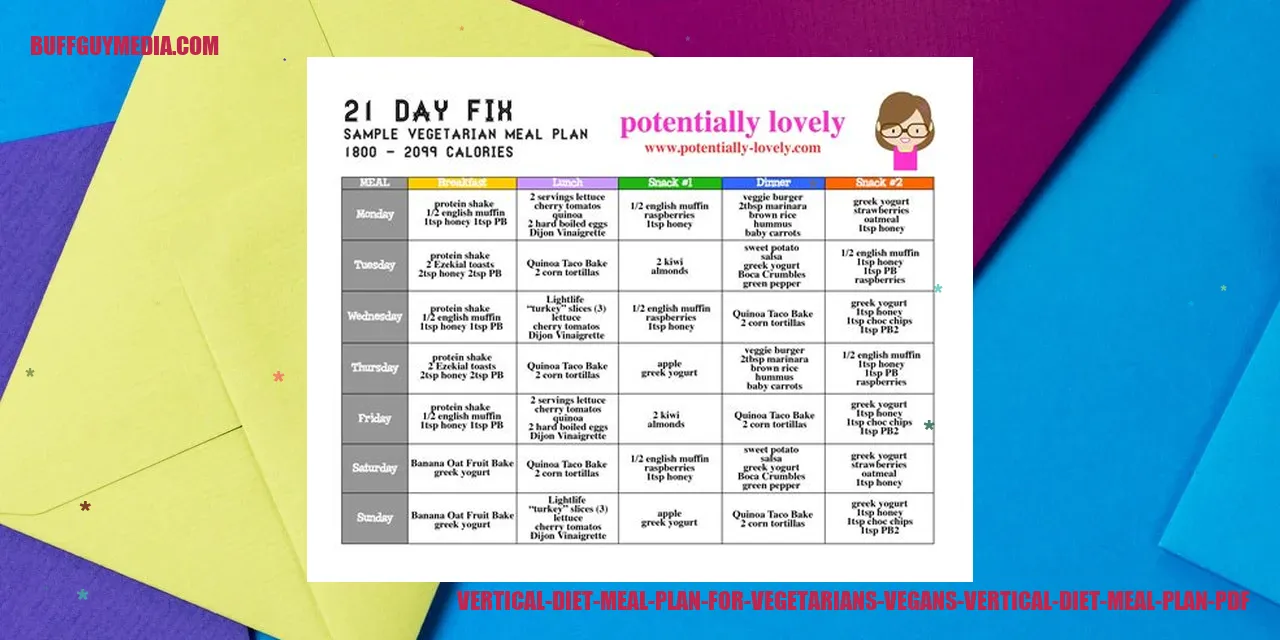
Adapting the Vertical Diet to Suit Vegetarian/Vegan Preferences
The Vertical Diet is a widely-followed meal plan known for its performance-enhancing benefits. However, due to its heavy reliance on animal products, vegetarians and vegans often face challenges in adopting this diet. To cater to these dietary choices, certain modifications need to be implemented.
Plant-Powered Protein Sources Complementing the Vertical Diet
Protein holds utmost significance in any diet, particularly for individuals who follow a vegetarian or vegan lifestyle. While animal-based protein sources like beef and eggs are emphasized in the Vertical Diet, plant-based alternatives can provide an equally well-rounded nutritional profile. Excellent sources of plant protein include legumes, tofu, tempeh, seitan, quinoa, chia seeds, and hemp seeds.
Meeting Nutritional Needs for Vegetarians/Vegans on the Vertical Diet
When following a vegetarian or vegan variation of the Vertical Diet, it is crucial to ensure sufficient intake of essential nutrients that are commonly found in animal products. For instance, dark leafy greens, lentils, and fortified cereals are excellent sources of iron. Plant-based milk alternatives, tofu, and leafy greens can fulfill the calcium requirement. Adequate intake of vitamin B12, primarily found in animal products, can be achieved through supplementation or consumption of fortified foods.
Sample Meal Plans for Vegetarians/Vegans following the Vertical Diet
Here are a few examples of meal plans that combine the core principles of the Vertical Diet with vegetarian or vegan options:
1. Breakfast: Start your day with a nourishing quinoa bowl topped with a medley of berries, chia seeds, and a dollop of almond butter.
2. Snack: Enjoy the crunch of celery sticks paired with creamy hummus.
3. Lunch: Savor a flavorsome lentil curry served with wholesome brown rice and a side of steamed broccoli.
4. Snack: Indulge in the savory delight of roasted chickpeas seasoned with aromatic spices.
5. Dinner: Delight in the goodness of grilled tofu skewers accompanied by luscious roasted sweet potatoes and a generous portion of sautéed spinach.
6. Dessert: Treat yourself to a delectable vegan protein smoothie made with plant-based milk, ripe banana, nutrient-rich spinach, and a scoop of vegan protein powder.
Remember, it is vital to tailor meal plans according to individual needs and preferences, ensuring a well-rounded and balanced vegetarian or vegan Vertical Diet.

The Benefits of the Vertical Diet for Stable Blood Sugar Levels
Optimal Food Choices for Blood Sugar Control on the Vertical Diet
The Vertical Diet is a well-designed eating plan that not only promotes stable blood sugar levels but also offers a wealth of essential nutrients to individuals seeking to manage their blood sugar. By focusing on nutrient-rich foods and thoughtful meal planning, this diet has demonstrated encouraging results in enhancing blood sugar control.
When following the Vertical Diet, it is important to prioritize foods that have a low glycemic index, as they result in a slower increase in blood sugar levels. These foods include leafy greens, non-starchy vegetables, lean proteins, and healthy fats. By incorporating these foods into your meals, you can obtain vital nutrients while minimizing sudden surges in blood sugar.
Conversely, it is crucial to steer clear of or limit foods that have the potential to cause rapid spikes in blood sugar levels. This includes beverages high in added sugars, processed snacks, refined carbohydrates, and foods that are rich in saturated and trans fats. By avoiding these foods, you can prevent elevated blood sugar levels and improve your diabetes management.
Effective Meal Planning Strategies for Diabetes Control on the Vertical Diet
Achieving successful meal planning on the Vertical Diet requires careful attention to portion sizes, macro-nutrient balance, and meal timing. Consider the following tips to effectively manage diabetes:
1. Optimal Portion Sizes: It is essential to maintain portion control to prevent overeating and maintain stable blood sugar levels. Utilize tools such as measuring cups or a food scale to measure your portions accurately.
2. Balanced Macro-nutrients: Aim for a balance of carbohydrates, proteins, and healthy fats in each meal. This balanced distribution of macro-nutrients can help prevent significant fluctuations in blood sugar levels.
3. Regular Meal Times: Establishing regular meal times can contribute to regulating blood sugar levels. Consistency in meal timing aids the body in efficiently producing and utilizing insulin.
Real-Life Success Stories of Improved Blood Sugar Control with the Vertical Diet
Countless individuals have experienced remarkable improvements in blood sugar control by adopting the Vertical Diet. By adhering to this meal plan, individuals have reported stabilized blood sugar levels, reduced reliance on medication, increased energy levels, and overall improvements in well-being.
For instance, John, a 45-year-old diagnosed with type 2 diabetes, began following the Vertical Diet and witnessed incredible changes in his blood sugar levels. Through consistent adherence to the diet, he successfully reduced his medication dosage and achieved stable blood sugar levels within just two months. John’s success story serves as a testimony to the positive impact the Vertical Diet can have on blood sugar control.
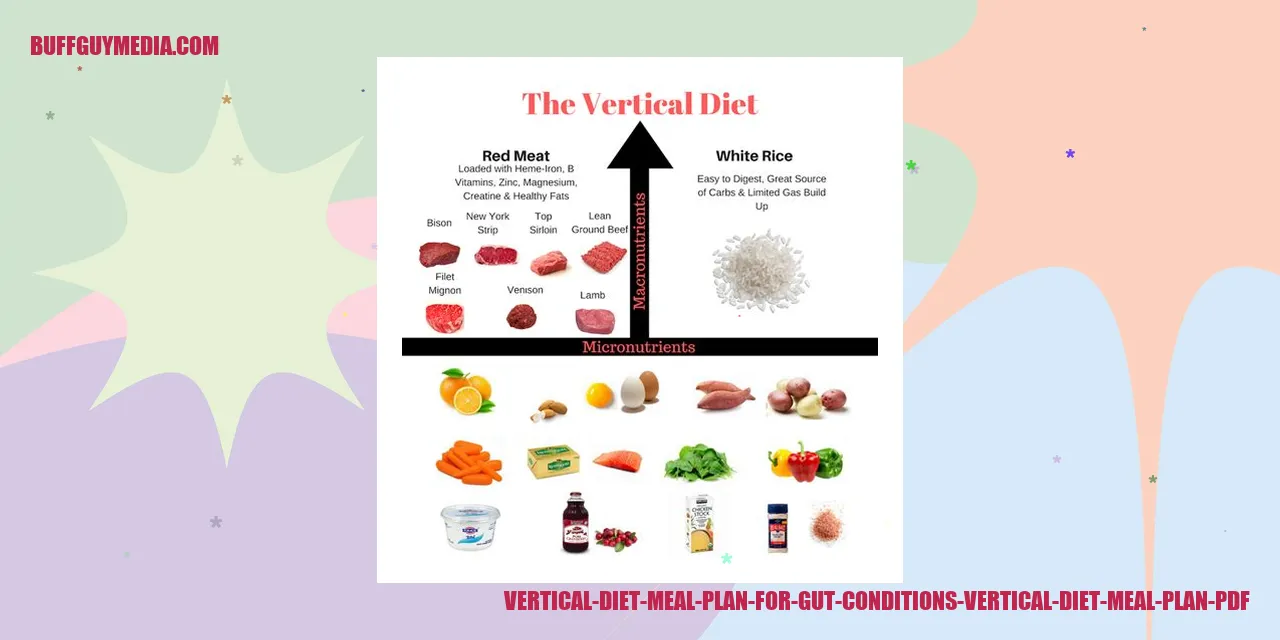
The Ultimate Guide to the Vertical Diet Meal Plan for Gut Conditions
Discovering the Benefits of the Vertical Diet for Individuals with Gut Conditions
Unlock the potential of the Vertical Diet, originally created to enhance athletic performance, for individuals dealing with gut conditions. By incorporating specific foods, it is possible to find solace from symptoms and promote healing within your gut.
Discover the Healing Power of Foods on the Vertical Diet
When tailored to support gut conditions, the Vertical Diet can work wonders in promoting gut healing. Key foods to incorporate are nourishing bone broth, vibrant fermented foods like sauerkraut or kimchi, and fiber-rich options such as fresh fruits, vegetables, and wholesome grains. These power-packed foods ensure the essential nutrients and foster the growth of beneficial gut bacteria, facilitating the healing process.
Master the Art of Meal Planning for Gut Conditions on the Vertical Diet
Crafting a well-thought-out meal plan is crucial for individuals dealing with gut conditions on the Vertical Diet. Opt for frequent, smaller meals to prevent overwhelming the digestive system. Prioritize easily digestible options like cooked vegetables and lean proteins to minimize stress on the gut. It’s also essential to be attuned to your body’s responses and avoid trigger foods that may exacerbate gut symptoms.
Discover Inspiring Stories of Gut Condition Sufferers Who Attained Relief with the Vertical Diet
Embark on a journey through the success stories of numerous individuals with gut conditions who have found respite and improved gut health through their adoption of the Vertical Diet. These compelling tales highlight the remarkable effectiveness of this diet in managing common symptoms like bloating, gas, and inflammation. By applying the principles of the Vertical Diet and customizing it to fit individual needs, many have experienced significant enhancements in their overall gut condition.

Optimizing Overall Well-being: The Vertical Diet Meal Plan for a Healthy Heart
Promoting Heart Health through the Vertical Diet
The Vertical Diet has gained significant recognition as a meal plan that not only enhances strength, performance, and weight management but also serves as a catalyst in improving heart health. This well-rounded and nutritionally sound dietary approach prioritizes nutrient-rich foods that provide essential vitamins, minerals, and antioxidants necessary for robust heart functioning and overall well-being.
Incorporating Heart-Healthy Foods into the Vertical Diet
When following the Vertical Diet with a focus on heart health, including specific foods can have remarkable benefits. Incorporating lean sources of protein, such as grass-fed beef and wild-caught fish, ensures the intake of crucial amino acids that foster heart muscle integrity and optimal function. Additionally, integrating whole grains like quinoa and brown rice into the diet provides dietary fiber, which aids in reducing cholesterol levels and diminishing the risk of heart disease.
Furthermore, the inclusion of an assortment of vibrant fruits and vegetables serves as a vital component in the Vertical Diet, as they supply essential vitamins, minerals, and antioxidants. These nutrients play a pivotal role in reducing inflammation, fortifying blood vessels, and safeguarding the heart against oxidative damage.
Meal Planning Strategies for Individuals with Heart Conditions on the Vertical Diet
For individuals with heart conditions, careful meal planning is crucial to optimize heart health. It is highly recommended to minimize sodium intake by opting for fresh, whole foods while avoiding processed and packaged items. Incorporating heart-healthy fats, such as avocados and olive oil, can help maintain favorable cholesterol levels and improve cardiovascular well-being. Additionally, consuming small, frequent meals throughout the day can aid in stabilizing blood sugar levels and minimizing the risk of heart-related complications.
Inspiring Stories of Heart Health Transformation with the Vertical Diet
Numerous individuals have experienced remarkable improvements in heart health by adopting the Vertical Diet. By adhering to this nutritional plan that prioritizes nutrient-dense foods, portion control, and regular physical exercise, individuals have reported reduced blood pressure, enhanced cholesterol levels, and improved overall cardiovascular fitness. These inspiring success stories serve as a beacon of hope and motivation for those seeking to prioritize heart health through their dietary choices.

Unveiling the Vertical Diet Meal Plan – Everything You Need to Know
Understanding the Vertical Diet and its Mechanism
The Vertical Diet is a revolutionary meal plan devised by the acclaimed powerlifter Stan Efferding. Its main focus lies in the consumption of wholesome, nutrient-packed foods to optimize performance and overall health. This diet mainly revolves around the consumption of minimally processed, whole foods including lean meats, rice, potatoes, fruits, and vegetables. It aims to provide a well-rounded intake of essential macronutrients, micronutrients, vitamins, and minerals to promote muscle growth, recovery, and sustained energy levels.
Is the Vertical Diet Viable for Everyone?
The Vertical Diet can potentially be beneficial for many individuals, but it is crucial to acknowledge and consider unique differences and consult with a healthcare professional or registered dietitian before embarking on any novel dietary plan. Certain medical conditions, dietary constraints, or personal preferences may necessitate tailored modifications or alternative approaches to cater to specific needs.
Can the Vertical Diet Be Customized to Suit Individual Tastes?
Absolutely! The Vertical Diet indeed allows for customization based on individual dietary preferences and requirements. While the core principles of the diet lay stress on the intake of nutrient-dense foods, there is room to substitute or adjust specific food choices to match personal taste or dietary restrictions. However, it is pivotal to maintain an overall balance of nutrients and the quality of the diet.
Potential Side Effects of Following the Vertical Diet
As with any dietary change, there is a chance of temporary side effects such as mild digestive disturbances or alterations in bowel movements. It is crucial to introduce the Vertical Diet gradually and attentively monitor your body’s response. In case of persistent or concerning side effects, it is advisable to seek guidance from a qualified healthcare professional.
How Soon Can One Expect Visible Results on the Vertical Diet?
The timeframe for observing tangible results on the Vertical Diet can vary depending on several factors, including individual body composition, level of physical activity, adherence to the diet, and overall health. While some individuals may experience improvements in energy levels and body composition within a few weeks, others may require more time. Consistently following the Vertical Diet and coupling it with suitable exercise is crucial for achieving desired outcomes.
Long-Term Sustainability of the Vertical Diet
The Vertical Diet is specifically designed to be sustainable and suitable for long-term adherence. However, it is important to periodically evaluate and adjust the diet based on evolving goals, preferences, and individual requirements. Regular monitoring and consultation with a healthcare professional or registered dietitian can ensure that the Vertical Diet continues to support optimal health and performance in the long run.
Additional Resources for Exploring the Vertical Diet
To dive deeper into the intricacies of the Vertical Diet, you can explore Stan Efferding’s official website and his critically acclaimed book titled “The Vertical Diet.” These resources offer comprehensive insights into the principles of the diet, food choices, meal plans, and practical implementation strategies. Additionally, seeking guidance from a registered dietitian well-versed in the Vertical Diet can provide personalized assistance and support tailored to your specific needs.


